Navigation
Soil Nitrogen Age Measurement Could Help Precision Agriculture Scientists Find
Scientists have developed a model to calculate the age of nitrogen in corn and soybean fields, which could lead to improved fertilizer application techniques to promote crop growth while reducing leaching. Nitrogen, a key nutrient for plants, can cause problems when it leaches into water supplies.
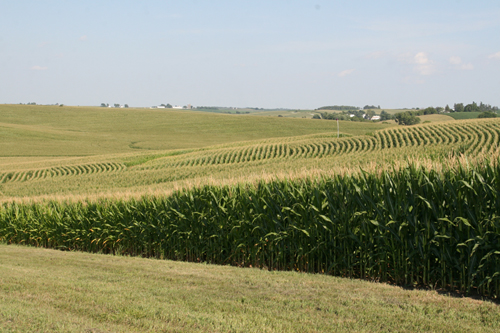 Corn fields in Iowa: Site of NSF's Intensively Managed Landscapes Critical Zone Observatory (CZO).: Photograph by Praveen Kumar courtesy of NSF.
Corn fields in Iowa: Site of NSF's Intensively Managed Landscapes Critical Zone Observatory (CZO).: Photograph by Praveen Kumar courtesy of NSF.
What's good for crops is not always good for the environment. Nitrogen, a key nutrient for plants, can cause problems when it leaches into water supplies. Plants take up nitrogen as a nutrient from the soil through their roots. Nitrogen is added to the soil through fertilizer application or by microbes in the soil breaking down organic compounds. If the soil contains more nitrogen than the plants need, nitrogen leaches out into the water and can accumulate in lakes, rivers and oceans. “Nitrogen undergoes many transformations in soil as it is used, re-used, and made available by soil microbes,” according to "Nitrogen Transformations in Soil" by Carol Frate (available at http://cdrf.org/wp-content/uploads/2012/01/11.7_Nitrogen_Transformations-final.pdf).
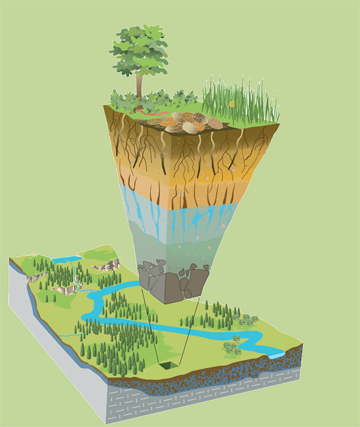 Where rock meets life: Researchers at NSF's Critical Zone Observatories study Earth's surface.: Photograph courtesy of NSFNow, scientists have developed a model to calculate the age of nitrogen in corn and soybean fields, which could lead to improved fertilizer application techniques to promote crop growth while reducing leaching.
Where rock meets life: Researchers at NSF's Critical Zone Observatories study Earth's surface.: Photograph courtesy of NSFNow, scientists have developed a model to calculate the age of nitrogen in corn and soybean fields, which could lead to improved fertilizer application techniques to promote crop growth while reducing leaching.
"By understanding how long nitrogen stays in the soil and the factors that drive that, we can improve the precision at which we apply nitrogen for agriculture productivity," Kumar said. "We may be able to apply fertilizer specifically in areas that are deficient in nitrogen, in precisely the amount that the plants need to uptake, rather than just applying it uniformly. Potentially, we could see a significant reduction in fertilizer amounts."
Researchers Praveen Kumar and Dong Kook Woo of the University of Illinois published their results on July 25, 2016 in the journal Water Resources Research, a publication of the American Geophysical Union.
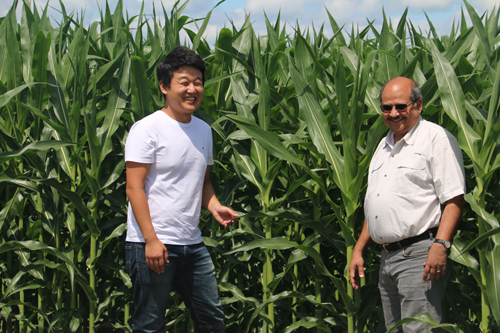 Scientists Dong Kook Woo (left) and Praveen Kumar study nutrients in corn productivity.: Photograph by Praveen Kumar courtesy of NSF.
Scientists Dong Kook Woo (left) and Praveen Kumar study nutrients in corn productivity.: Photograph by Praveen Kumar courtesy of NSF.
The National Science Foundation (NSF) supported the research through its Critical Zone Observatory (CZO) for Intensively Managed Landscapes, one of 10 such NSF CZOs.
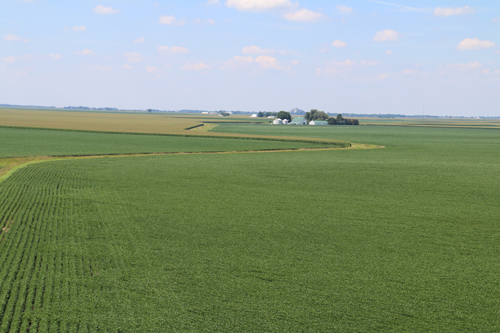 The Midwest offers the most productive soils in the U.S. for corn and soybean crops.: Photograph by Praveen Kumar courtesy of NSF.
The Midwest offers the most productive soils in the U.S. for corn and soybean crops.: Photograph by Praveen Kumar courtesy of NSF.
Overdosing the environment
"Nitrogen, usually in the form of nitrate fertilizer, is needed for healthy crop production, but too much is not a good thing, since the excess can contaminate water supplies," said Richard Yuretich, program director in the NSF's Division of Earth Sciences. "Knowing how long nitrate resides in the soil will lead to more efficient agriculture that maximizes plant health without overdosing the environment."
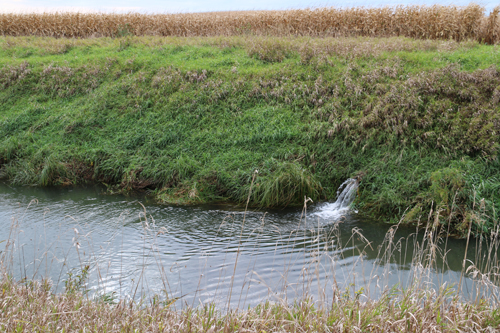
Kumar and Woo developed a numerical model to calculate how long inorganic nitrogen has been in the soil, using a corn-corn-soybean rotation common in the Midwest.
Fresh fertilizer application or microbial production of nitrates and ammonium are considered "age zero" in the numerical model. From there, the researchers compute age by the chemical reactions or transformations nitrogen goes through in the soil, mediated by moisture, temperature and microbes.
Comparing corn and soybeans
The model revealed two surprising findings when comparing the average age of nitrogen in the topsoil with that in deeper layers, and in comparing cornfields with soybean fields.
"The biggest surprise was that we found a lower average age of nitrogen in soybean fields," Woo said. "We use fertilizer on corn, not soybeans. Yet even though we count that fresh fertilizer as age zero, we found a lower average age of nitrogen in soybean fields. We found that is mainly because soybeans uptake the old nitrogen, so the average age is reduced."
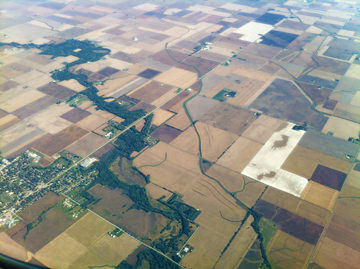 Scientists affiliated with NSF's Intensively Managed Landscapes CZO track land-use changes.: Photograph by Praveen Kumar courtesy of NSF.
Scientists affiliated with NSF's Intensively Managed Landscapes CZO track land-use changes.: Photograph by Praveen Kumar courtesy of NSF.
When looking at the layers of soil, the researchers initially expected that nitrogen would follow a similar age path to water: newer on top, and growing older as it migrates down through the soil. However, they found that the nitrogen topsoil had a relatively high average age when compared with the water. Looking closer, they realized that one of the forms of nitrogen -- ammonium -- accumulated in the topsoil.
"Ammonium has a positive [electric] charge, which adheres to the soil particles and prevents it from leaching to the deeper layers," Woo said. "Because of that, we observe relatively higher nitrogen age in the upper layers, compared with the age of the nitrate that dissolves in water, which doesn't have that barrier and can migrate down through the soil."
Helping farmers use resources wisely
The researchers have established a field site to validate their model by analyzing the composition of nitrogen, oxygen and water in runoff. They hope their work can help farmers more efficiently use resources while also reducing contamination of water sources and downstream habitats.
"The idea of using age for chemical analysis is not new, but no one has studied nitrogen age in the context of an agricultural setting," Kumar said. "By doing that, we are able to reveal patterns of stagnation in the soil, which is different than just using the concentration of nitrogen. The main idea is that there is a better way to apply fertilizer over a landscape than we do presently. We should be looking into more precise approaches."
This news is from the National Science Foundation 25 July 2016. The article was published on the Horizon International Solutions SIte on 31 July 2016.
Search
Latest articles
Agriculture
- World Water Week: Healthy ecosystems essential to human health: from coronavirus to malnutrition Online session Wednesday 24 August 17:00-18:20
- World Water Week: Healthy ecosystems essential to human health: from coronavirus to malnutrition Online session Wednesday 24 August 17:00-18:20
Air Pollution
- "Water and Sanitation-Related Diseases and the Changing Environment: Challenges, Interventions, and Preventive Measures" Volume 2 Is Now Available
- Global Innovation Exchange Co-Created by Horizon International, USAID, Bill and Melinda Gates Foundation and Others
Biodiversity
- It is time for international mobilization against climate change
- World Water Week: Healthy ecosystems essential to human health: from coronavirus to malnutrition Online session Wednesday 24 August 17:00-18:20
Desertification
- World Water Week: Healthy ecosystems essential to human health: from coronavirus to malnutrition Online session Wednesday 24 August 17:00-18:20
- UN Food Systems Summit Receives Over 1,200 Ideas to Help Meet Sustainable Development Goals
Endangered Species
- Mangrove Action Project Collaborates to Restore and Preserve Mangrove Ecosystems
- Coral Research in Palau offers a “Glimmer of Hope”
Energy
- Global Innovation Exchange Co-Created by Horizon International, USAID, Bill and Melinda Gates Foundation and Others
- Wildlife Preservation in Southeast Nova Scotia
Exhibits
- Global Innovation Exchange Co-Created by Horizon International, USAID, Bill and Melinda Gates Foundation and Others
- Coral Reefs
Forests
- NASA Satellites Reveal Major Shifts in Global Freshwater Updated June 2020
- Global Innovation Exchange Co-Created by Horizon International, USAID, Bill and Melinda Gates Foundation and Others
Global Climate Change
- It is time for international mobilization against climate change
- It is time for international mobilization against climate change
Global Health
- World Water Week: Healthy ecosystems essential to human health: from coronavirus to malnutrition Online session Wednesday 24 August 17:00-18:20
- More than 400 schoolgirls, family and teachers rescued from Afghanistan by small coalition
Industry
- "Water and Sanitation-Related Diseases and the Changing Environment: Challenges, Interventions, and Preventive Measures" Volume 2 Is Now Available
- Global Innovation Exchange Co-Created by Horizon International, USAID, Bill and Melinda Gates Foundation and Others
Natural Disaster Relief
- STOP ATTACKS ON HEALTH CARE IN UKRAINE
- Global Innovation Exchange Co-Created by Horizon International, USAID, Bill and Melinda Gates Foundation and Others
News and Special Reports
- World Water Week: Healthy ecosystems essential to human health: from coronavirus to malnutrition Online session Wednesday 24 August 17:00-18:20
- STOP ATTACKS ON HEALTH CARE IN UKRAINE
Oceans, Coral Reefs
- World Water Week: Healthy ecosystems essential to human health: from coronavirus to malnutrition Online session Wednesday 24 August 17:00-18:20
- Mangrove Action Project Collaborates to Restore and Preserve Mangrove Ecosystems
Pollution
- Zakaria Ouedraogo of Burkina Faso Produces Film “Nzoue Fiyen: Water Not Drinkable”
- "Water and Sanitation-Related Diseases and the Changing Environment: Challenges, Interventions, and Preventive Measures" Volume 2 Is Now Available
Population
- "Water and Sanitation-Related Diseases and the Changing Environment: Challenges, Interventions, and Preventive Measures" Volume 2 Is Now Available
- "Water and Sanitation-Related Diseases and the Changing Environment: Challenges, Interventions, and Preventive Measures" Volume 2 Is Now Available
Public Health
- Honouring the visionary behind India’s sanitation revolution
- Honouring the visionary behind India’s sanitation revolution
Rivers
- World Water Week: Healthy ecosystems essential to human health: from coronavirus to malnutrition Online session Wednesday 24 August 17:00-18:20
- Mangrove Action Project Collaborates to Restore and Preserve Mangrove Ecosystems
Sanitation
- Honouring the visionary behind India’s sanitation revolution
- Honouring the visionary behind India’s sanitation revolution
Toxic Chemicals
- "Water and Sanitation-Related Diseases and the Changing Environment: Challenges, Interventions, and Preventive Measures" Volume 2 Is Now Available
- Actions to Prevent Polluted Drinking Water in the United States
Transportation
- "Water and Sanitation-Related Diseases and the Changing Environment: Challenges, Interventions, and Preventive Measures" Volume 2 Is Now Available
- Urbanization Provides Opportunities for Transition to a Green Economy, Says New Report
Waste Management
- Honouring the visionary behind India’s sanitation revolution
- Honouring the visionary behind India’s sanitation revolution
Water
- Honouring the visionary behind India’s sanitation revolution
- Honouring the visionary behind India’s sanitation revolution
Water and Sanitation
- Honouring the visionary behind India’s sanitation revolution
- Honouring the visionary behind India’s sanitation revolution

